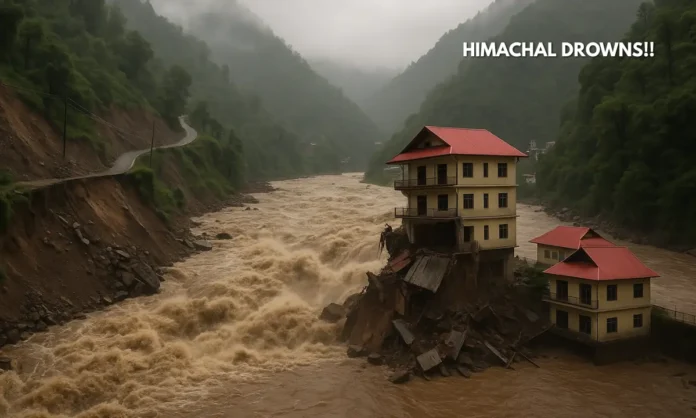SUMMARY
- Over 63 people dead, 40 missing, and ₹400 crore in property losses as Himachal faces relentless cloudbursts and flash floods.
- Mandi district’s Thunag region cut off; 246 roads blocked, 784 water schemes disrupted, 31 bridges collapsed.
- IMD red alert till July 7, with more rainfall expected; rescue operations underway by NDRF, IAF, and local authorities.
“Everything Just Collapsed”: Inside Himachal’s Deadliest Monsoon in Years
What began as seasonal rain has now turned into one of the most destructive monsoons Himachal Pradesh has faced in the last decade. Over 63 lives have been lost, 40 people remain missing, and property damage has crossed ₹400 crore, according to early official estimates. With rivers in spate, embankments collapsing, and landslides eating into highways and apple orchards alike, the state’s fragile infrastructure has given way under the weight of continuous cloudbursts.
The worst-hit is the Thunag sub-division in Mandi, where roads are now impassable and power and water supply have been paralyzed. Across the hill state, 246 roads are closed, most of them in Mandi alone. Relief helicopters from the Indian Air Force have been pressed into service to drop essential food and medical supplies into cut-off areas like Janjheli and Thunag.
As of July 3, the India Meteorological Department (IMD) has issued a red alert for extreme rainfall through July 7, warning of continued downpours that could worsen already precarious conditions. The crisis isn’t just natural—it is systemic. Locals blame poor maintenance of safety structures and delayed disaster preparedness. And once again, the Himalayas are bleeding under the weight of policy neglect and climate unpredictability.
हिमाचल प्रदेश में भारी बारिश और भूस्खलन से 13 दिनों में अब तक 63 लोगों की मौत हुई
— News24 (@news24tvchannel) July 4, 2025
◆ अब तक 40 लोग लापता है, राज्य को अब तक प्राकृतिक आपदा से 400 करोड़ से अधिक का नुकसान हो गया है #HimachalPradesh | Himachal Pradesh | Monsoon | #Monsoon pic.twitter.com/ABWaj9dxr1
A Region in Ruins: Roads, Homes, and Lives Washed Away
- More than 150 homes and 106 cattle sheds destroyed; 164 cattle dead.
- 14 bridges collapsed, cutting off rural belts from critical access.
- 31 vehicles, including ambulances and goods carriers, lost to flash floods.
- In Mandi alone, 40 people are missing and 348 rescued.
- Relief camps set up; ration kits airdropped; ISRO’s ISATs deployed for emergency communication.
Entire villages have been flattened in flash floods. In the Kaithlighat-Dhalli region, the collapse of a four-lane road embankment left homes teetering over voids and devastated hundreds of apple trees—Himachal’s key cash crop. Local anger is rising: villagers allege the National Highway Authority of India (NHAI) ignored previous warnings after the same safety wall had failed earlier.
In Shimla’s Dhalli suburb, a massive landslide triggered panic as a hillside gave way, though no casualties were reported. Further north, the Manali-Keylong road was shut down, and all traffic diverted via Rohtang Pass after flash flooding near Solang Nallah.
Rescue Amid Ruin: NDRF, IAF, and Local Heroes Step In
- NDRF and SDRF teams deployed across Mandi and affected districts.
- IAF helicopters airlift rations and supplies to inaccessible zones.
- Jal Shakti department initiates gravity-fed chlorinated water systems for safe drinking water.
- DoT activates Intra Circle Roaming (ICR) and mobilizes ISAT phones for critical field connectivity.
The State Disaster Response Force, backed by the NDRF and home guards, has scrambled to reach stranded families. With field coordination hampered by road blockages and destroyed towers, the Department of Telecommunications activated ICR, allowing users to latch onto other networks in Thunag. ISAT satellite phones are now the only reliable line of communication in remote sectors.
Meanwhile, Leader of Opposition Jairam Thakur described his constituency, Seraj, as the “worst-hit in the state”—with over 500 houses damaged. Chief Minister Sukhvinder Singh Sukhu confirmed that five major relief camps are running and that the damage total of ₹400 crore is only preliminary.
The Politics of Prevention: Why It Keeps Failing in Himachal
- Safety walls collapsed again—despite warnings and prior failures.
- Poor maintenance of high-altitude road infrastructure exacerbated landslide risks.
- Emergency preparedness remained reactive, not anticipatory, even after the 2023 and 2024 flash floods.
The pattern is cruelly familiar: cloudbursts lead to road collapses, isolating entire tehsils; landslides wash away villages; and basic services like water and electricity vanish just when they are needed most. Despite the state’s ₹400 crore tourism economy depending on this season, very little has been done to climate-proof its infrastructure.
The climate crisis is no longer hypothetical. Increased moisture in the atmosphere, retreating glaciers, and unregulated development are converging to make Himachal’s monsoon deadlier with every passing year.
The Final Climb: Recovery, Resilience, and What Comes Next
As the death toll rises and more rains loom, Himachal Pradesh stares at yet another prolonged season of grief. Relief efforts are underway, and aerial rescues are being conducted—but the long-term damage, both economic and emotional, is mounting silently.
Rebuilding roads and homes is urgent. But rebuilding trust in governance, credibility in infrastructure, and preparedness for monsoon disasters is just as critical. Otherwise, the state will continue to slide into this preventable tragedy every July.
For now, with heavy rainfall forecast until July 7, the mountains remain on edge—and the rest of India must watch, worry, and hopefully learn.


